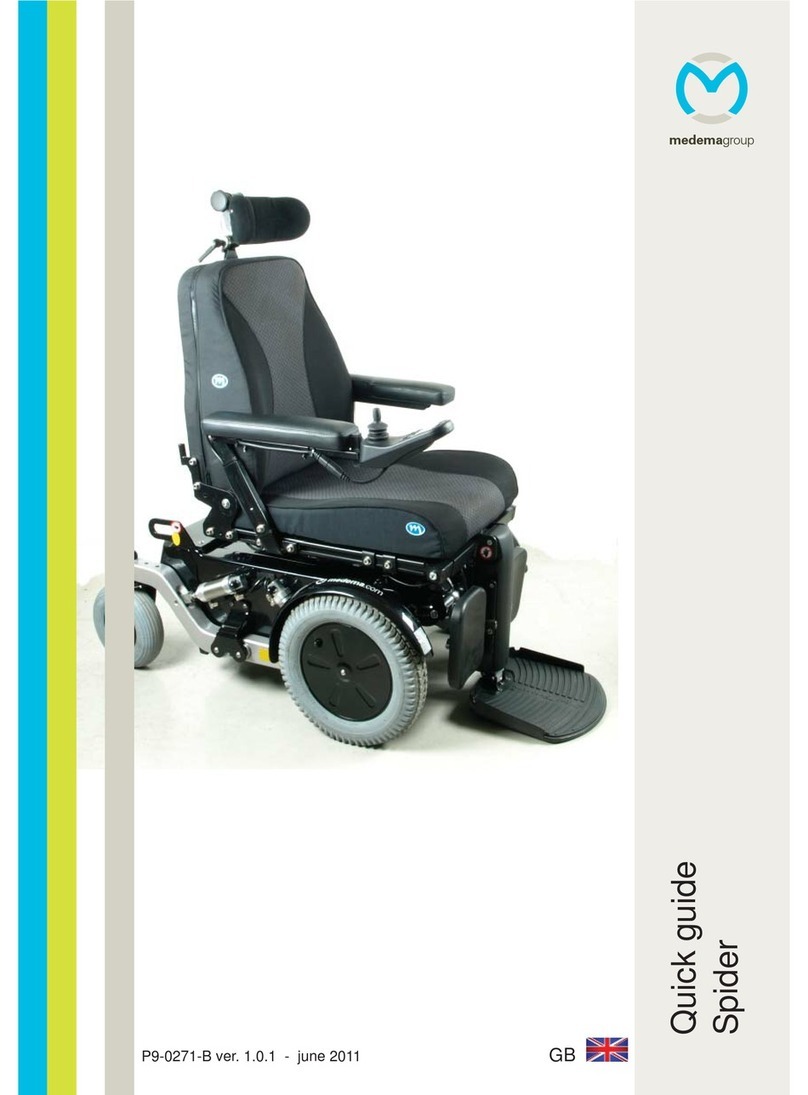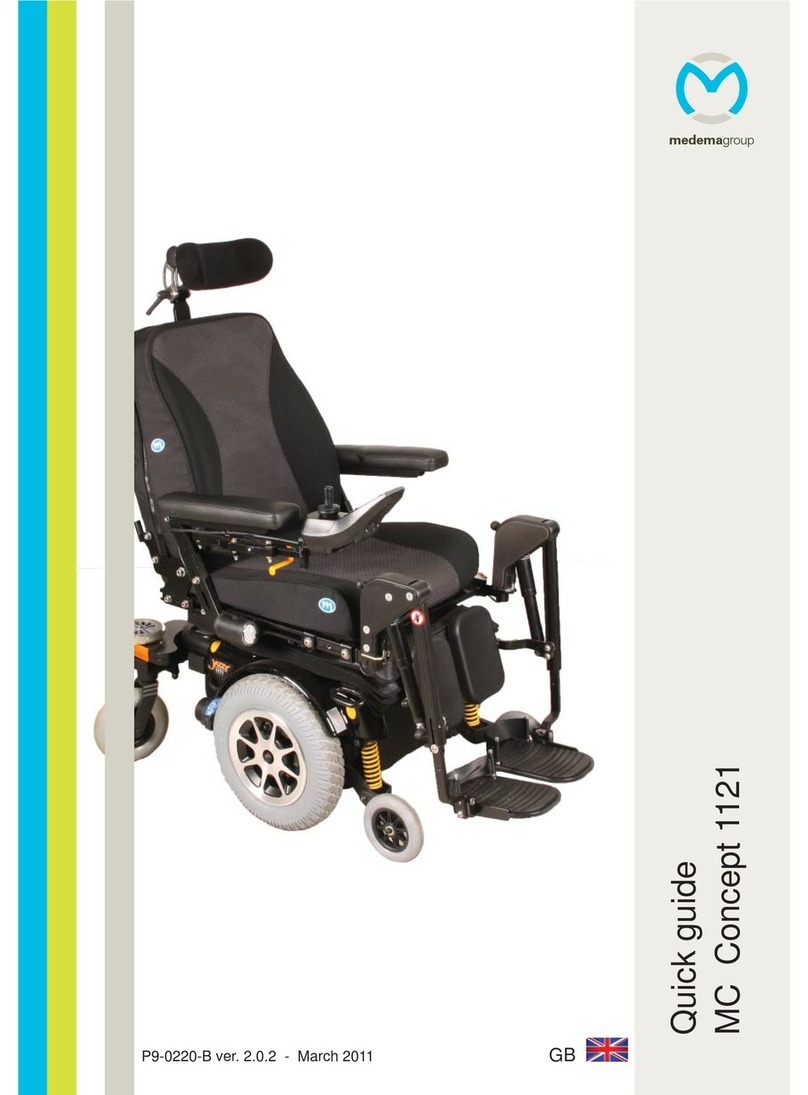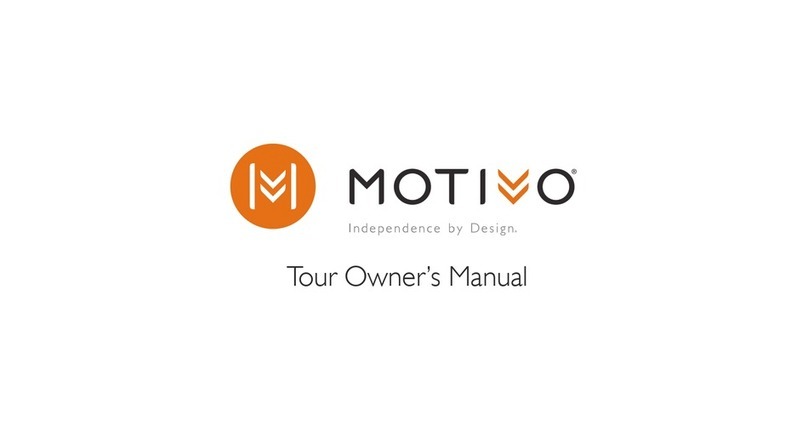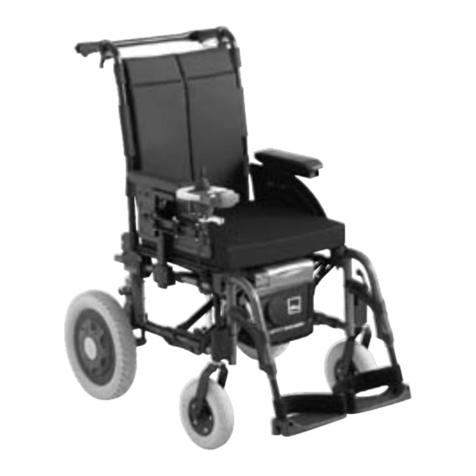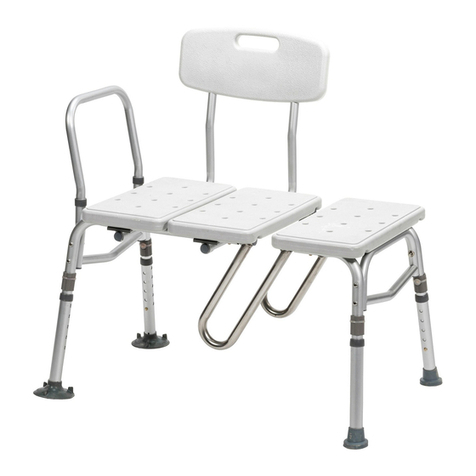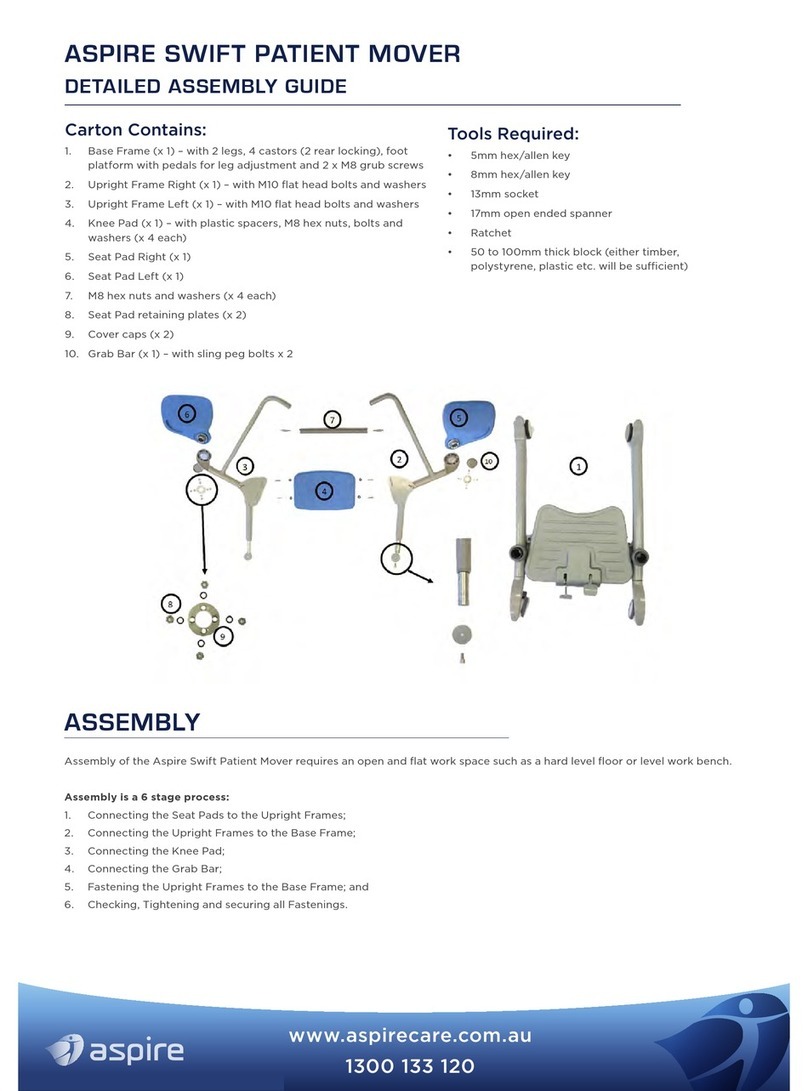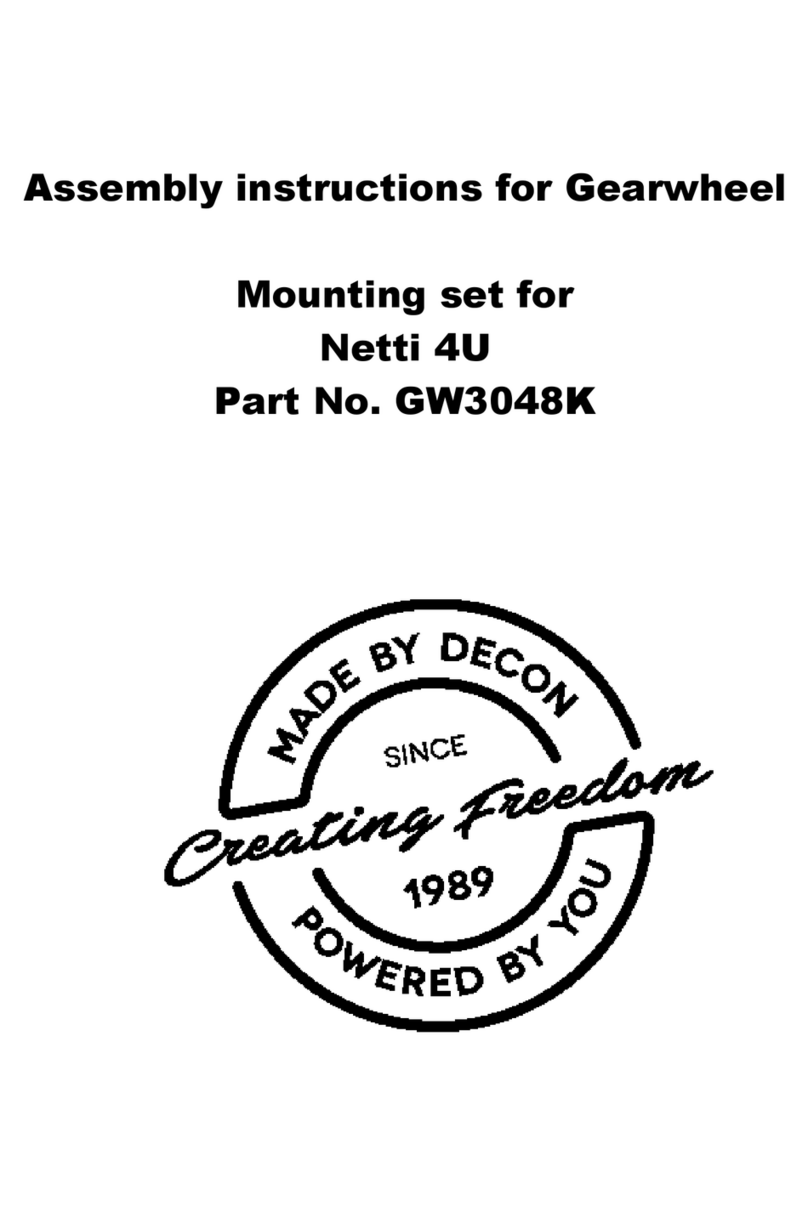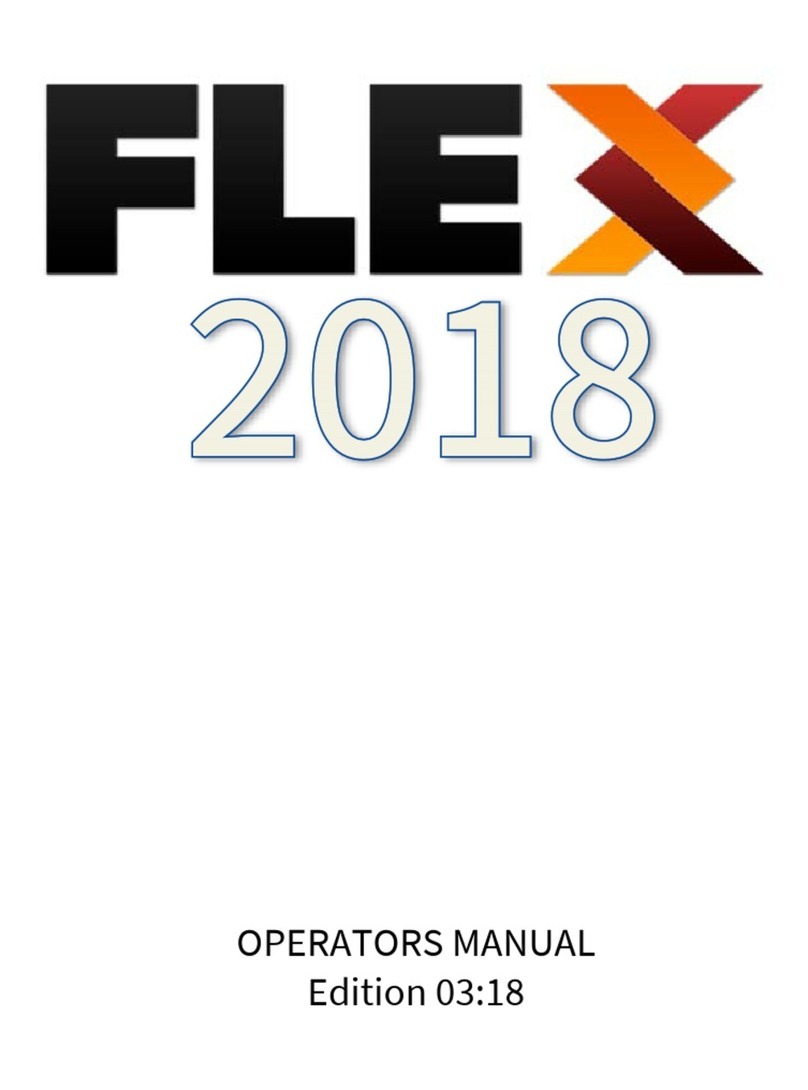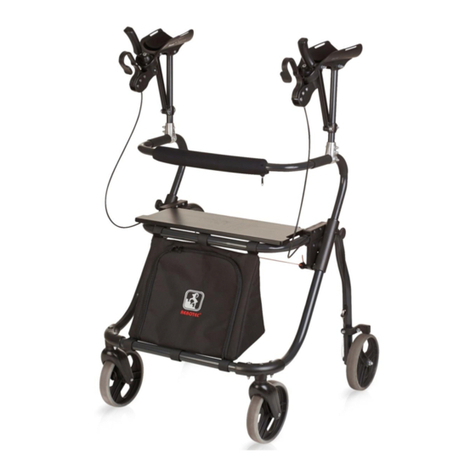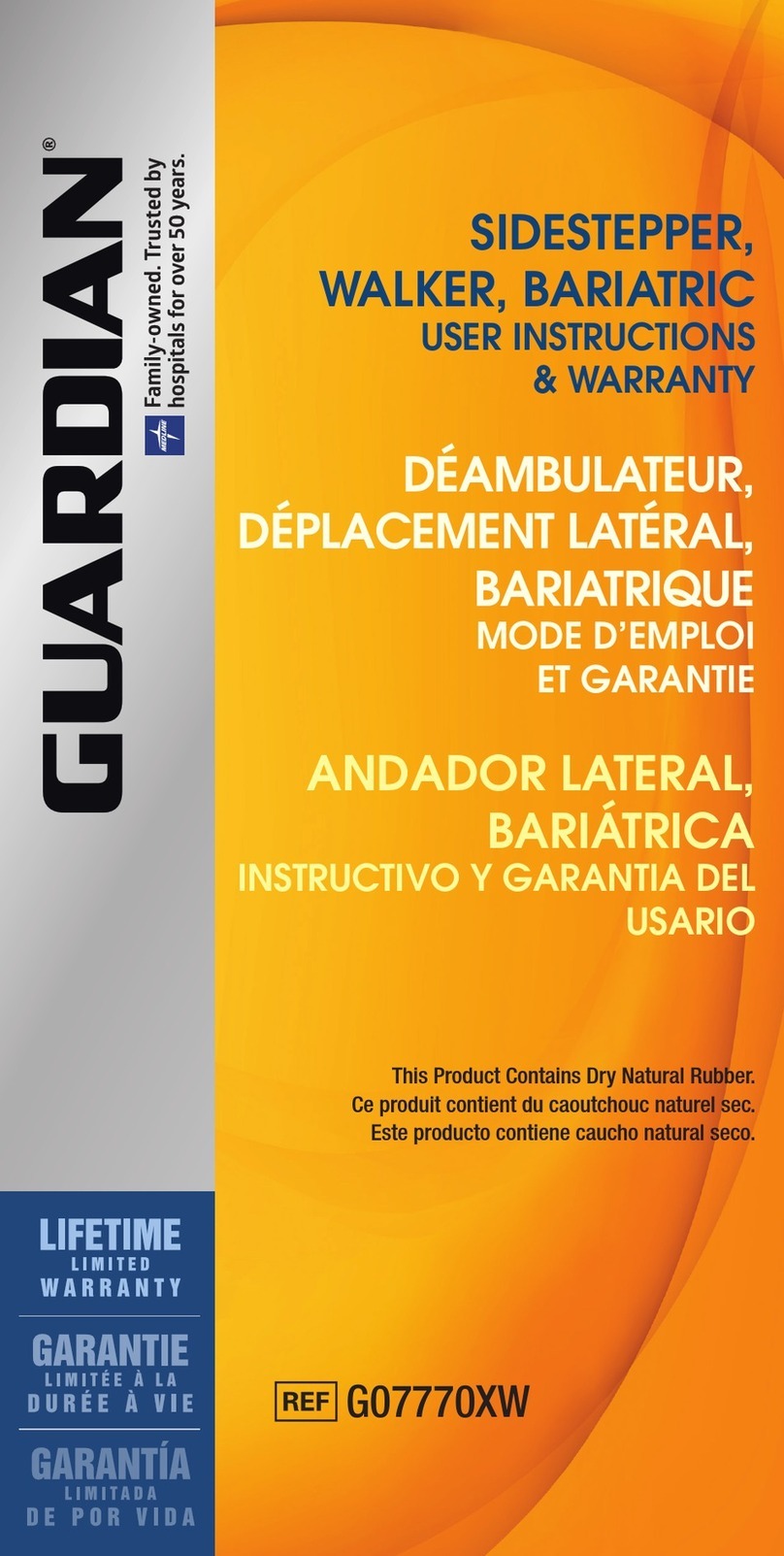Medema Mini Crosser M joy User manual

User Manual
Mini Crosser M joy
P9-0158-B ver. 1.0.2 - July 2012 GB
medemagroup
U
ser Manual
M
ini
C
rosser M
j
o
y
m
e
d
ema
gr
oup

User guide P9-0158-B 2 of 48 Version 1.0.2/2011
Medema Production A/S
Serial number: ___-______________-______-_______
Delivery date: ________________ Year 20______
This vehicle was supplied by: Date: /

User guide P9-0158-B 3 of 48 Version 1.0.2/2012
Medema Production A/S
Contents
Symbols.................................................................................. 4
Warning!................................................................................. 4
Contagion!.............................................................................. 4
Introduction............................................................................ 5
Declaration of conformity..................................................... 6
Designations.......................................................................... 7
Joystick parts ........................................................................ 8
Using the G90T and G90A .................................................... 9
Safety check Joystick........................................................... 10
General care and maintenance ............................................ 11
Insurance................................................................................ 12
Preparations / Adjustments prior to use............................. 13
Electric seat adjustment....................................................... 14
Seat rotation........................................................................... 15
Serial number......................................................................... 16
Driving the Mini Crosser M Joy ........................................... 17
Specific driving situations.................................................... 22
Anti-tilt wheels / stabilisers.................................................. 24
Batteries................................................................................. 25
Charging................................................................................. 25
Battery disposal..................................................................... 27
Storage................................................................................... 27
Cleaning ................................................................................. 27
Changing the wheels............................................................. 28
Fuses...................................................................................... 29
Brakes..................................................................................... 30
Disengagement...................................................................... 31
Transporting by motor vehicle............................................. 31
Securing to vehicle floor with belts..................................... 32
Transporting by plane........................................................... 35
Towing.................................................................................... 35
Dimensioned drawing, Mini Crosser M Joy 4W.................. 36
Introduction to seats - Ergo Standard................................. 37
Introduction to seats - Mando.............................................. 39
Troubleshooting .................................................................... 40
Troubleshooting the Dynamic.............................................. 41
Programming......................................................................... 43
Technical data........................................................................ 43
International addresses........................................................ 46

User guide P9-0158-B 4 of 48 Version 1.0.2/2011
Medema Production A/S
Symbols
Used in the manual to indicate sections describing situations
where extra care is required owing to the risk of personal injury.
Used to indicate sections on electromagnetic compatibility
(EMC).
Warning!
For safety reasons the vehicle must not be lent to persons who
are not completely familiar with it. The vehicle is designed for
one person only.
The Mini Crosser MJoy has been designed for users weighing
max. 150 kg.
Joystick
The joystick control box must not be exposed to extremes
of temperature or kept in a damp environment for extended
periods.
The joystick control box must not be subjected to heavy knocks.
Do not switch off the control box while driving, except in an
emergency, as this may damage the electronics.
For cleaning, use a damp cloth with slightly soapy water.
Do NOT allow any water or moisture to enter the control box.
Contagion!
Note!
The tires can sometimes rub off on floor coverings, particularly
linoleum. Medema Production assumes no responsibility in
case of contagion.
To prevent this, we recommend that you protect delicate floors
with some sort of driving surface.

User guide P9-0158-B 5 of 48 Version 1.0.2/2012
Medema Production A/S
Introduction
Congratulations on your new Mini Crosser MJoy electric
mobility scooter.
You have now taken possession of an electric mobility scooter
developed for outdoor driving by active users. It is what is
called a Class C vehicle in accordance with the European
classification of electric scooters.
For optimum enjoyment of this vehicle - and to avoid
breakdowns and accidents - we recommend that you read this
User Manual carefully. As a new user, you should pay particular
attention to the section entitled “Driving the Mini Crosser MJoy”.
The Mini Crosser M
Joy is designed for safe travel for at least 10
years, up to a max. of 5,000 hours, provided it is serviced and
safety-checked every year, corresponding to 500 hours of operation.
The service must be carried out by an authorised workshop.
IMPORTANT! For safety reasons it is of the utmost importance
that service and safety check intervals are complied with, as
this minimises the risk of brake failure and short-circuits in the
wiring, which could generate heat and cause a fire.
We offer a wide range of accessories for the Mini Crosser
MJoy that can make everyday life easier for you. You are
always welcome to contact us for further information on special
accessories and adaptations.
Medema Production A/S is not responsible for any damage
or injuries caused by inappropriate or unsafe use of the Mini
Crosser MJoy.
If you have any further questions about the Mini Crosser MJoy
or this User Manual, you are always welcome to get in touch.
Our contact details are as follows:
Medema Production A/S
Tel: +45 7010 2054
Email: info@minicrosser.com
Internet: www.minicrosser.dk
NB: Errors and omissions excepted. We reserve the right to
update this manual as required.

User guide P9-0158-B 6 of 48 Version 1.0.2/2011
Medema Production A/S
Declaration of conformity
Medema Production A/S hereby declares that:
Machine: Mini Crosser
Use: (Prescribed use in
User Manual)
Model No: MJoy
Complies with the Medical Device Directive 93/42/EEC
The product is made in accordance with the harmonized
standard EN 12184 - Electrically powered wheelchairs, scooters
and their chargers.
The product is risk analysed in accordance with the harmonized
standard DS/EN ISO 14971:2007-04-10 2. edition - Medical
devices - Application of risk management to medical devices.
The Mini Crosser can, for a fee, be taken to the nearest
dealer for disposal in accordance with current environmental
regulations.
Manufacturer: Medema Production A/S
Address: Enggårdvej 7, DK-7400 Herning
Tel./Fax +45 7010 2054 +45 9716 8582
Date: 12.04.2010 Signature: _____________________

User guide P9-0158-B 7 of 48 Version 1.0.2/2012
Medema Production A/S
Designations
The following designations refers to the explanation later in the
instruction book.
JoystickControl panel
Headrest (not shown)
(Extra)
Thermal fuse
Disengagement lever
Seat rotation
Release handle
forw. / backw.
Eye for restraints
Indicator
lights
Finger screw
Charging
socket
Serial number on
vehicle.
Eye for
restraints
Handbrake

2
4
3
9
10
5
6
1A
3
7
8
1B
2
4
3
10
5
6
1
9
11
7
8
User guide P9-0158-B 8 of 48 Version 1.0.2/2011
Medema Production A/S
Joystick parts
Dynamic G90T Dynamic G90A
1A Start/stop button (push button) 1 Start/stop button
1B Start/stop button (toggle switch) 2 Display
2 Display 3 Select program
3 Gear down/up 4 Display for seat functions (not
available)
4 Display for seat functions (not
available) 5 Battery indicator
5 Battery indicator 6 Magnetic lock
6 Magnetic lock 7 Horn
7 Horn 8 Joystick
8 Joystick 9 Lights, hazard warning lights
and indicators
9 Light, hazard warning lights and
indicators 10 Indicator left/lights
10 Select seat function (toggle
switch) (not available) 11 Indicator right/hazard warning
lights.
Extra locking system:
Mini Crosser has besides start / stop (I / O button) an additional
locking system to ensure unauthorized use of vehicle, in the
form of a small magnetic key that comes with a keychain.
Keep magnetic key to the key icon on the joystick, you will hear
a signal, and after a few seconds the scooter can not run. Turn
the scooter on now (I / O button), a single red lamp is lit. When
you want to use the scooter again, hold the magnetic key back
to the key symbol, and now you can drive again.
Should you lose the magnetic key, any magnet can be used.

2
4
3
9
10
5
6
1A
3
7
8
1B
2
4
3
10
5
6
1
9
11
7
8
User guide P9-0158-B 9 of 48 Version 1.0.2/2012
Medema Production A/S
Using the G90T and G90A
Speed selection with G90T Speed selection with G90A
1 To start the scooter:
Press button 1A or use toggle
switch 1B
Wait for the battery indicator to
stabilise (3-5 seconds)
1 To start the scooter:
Press button 1 and wait for the
battery indicator to stabilise (3-5
seconds)
2 Select the maximum speed:
Keep pressing button 3 or
toggle switch 10 to change the
numbers between 1, 2, 3, 4 and
5. 1 is the lowest speed and 5
is the highest. (This may vary.
Some scooters have a maximum
speed of 3).
2 Select the maximum speed:
Keep pressing button 3 to
change the numbers between
1, 2, 3, 4 and 5 on the display.
Select the speed you want. 1 is
the lowest speed and 5 is the
highest.
Driving Driving
1 Start driving by moving the
joystick in the direction you want
to travel. The speed depends
on how far forward you push
the joystick. To brake, return the
joystick to the starting position in
the centre.
1 Start driving by moving the
joystick in the direction you want
to travel. The speed depends
on how far forward you push
the joystick. To brake, return the
joystick to the starting position in
the centre.
2 It is important to check the
battery indicator regularly to
prevent the scooter stopping
because of flat batteries.
2 It is important to check the
battery indicator regularly to
prevent the scooter stopping
because of flat batteries.
Note!
If you are driving on a sloping surface with poor grip, e.g. gravel
or snow, it is important to brake gently to avoid losing control
of the scooter. To brake gently: move the joystick to the central
position SLOWLY.

User guide P9-0158-B 10 of 48 Version 1.0.2/2011
Medema Production A/S
Safety check Joystick
Daily safety check:
The electronic system has an integrated safety check which
runs up to 100 times per minute. To supplement this check, you
should carry out the following regular checks.
• Switch off the electronic system (no lights in the display)
• Check if the joystick is bent
• Check if the joystick is damaged in any other way
• Check that it returns to the central position when you release it
If the check reveals any problems, contact a competent service
engineer before using the scooter again.
Weekly safety check:
Parking brake: This test must be carried out on a flat surface
with at least one metre of free space around the scooter.
• Start the scooter and slowly move the joystick forward. There is a
clicking sound. (The scooter may start to move in this setting).
• Immediately release the joystick and listen for the clicking sound,
which should occur within one second.
Repeat in all directions.
• Check that the rubber bellows around the joystick is intact. This
is important, as the bellows prevent moisture getting into the
electronic system.
• Check that the control box is properly secured.
If the check reveals any problems, contact a competent service
engineer before using the scooter again.
Monthly check
Check the tyre pressure at least once a month. It should be 2.8
bar.

User guide P9-0158-B 11 of 48 Version 1.0.2/2012
Medema Production A/S
General care and maintenance
A Mini Crosser M Joy does not require much maintenance. It
should be kept in a generally good condition, however. The
following should be checked regularly:
• Tyre pressure (if pneumatic tyres are fitted)
• Tyre wear
• Keep the control panel, the charging socket and the electronics
box under the seat dry.
• Battery charging
Never wash the Mini Crosser with a high-pressure cleaner
or direct water jet! This could damage the Mini Crosser’s
electronics.
To keep the Mini Crosser in good condition safety-wise, we
recommend the following regular checks:
Daily:
• Test the indicators and driving lights before using the Mini Crosser
in the dark or poor visibility.
Every three months:
Test the brakes and motor disengagement
With the disengagement lever up, it must not be possible to
push the Mini Crosser.
Test the brake disengagement function
When the brake disengagement lever is down, the battery
indicator should flash to show an error if the Mini Crosser is
turned on. In this case the Mini Crosser must not be able to
move when the joystick is activated.
Test the handbrake.
Apply the handbrake for a couple of seconds at low speed. This
will ensure that the lever arm and brake shoes do not seize up.
Lubricate the lever arm on the brake hub with acid-free oil - left-
hand rear wheel.

User guide P9-0158-B 12 of 48 Version 1.0.2/2011
Medema Production A/S
Annual
The Mini Crosser M
Joy is designed for safe travel for at least 10
years, up to a max. of 5,000 hours, provided it is serviced and
safety-checked every year, corresponding to 500 hours of operation.
The service must be carried out by an authorised workshop.
IMPORTANT! For safety reasons it is of the utmost importance
that service and safety check intervals are complied with, as
this minimises the risk of brake failure and short-circuits in the
wiring, which could generate heat and cause a fire.
(More information in the service manual).
Insurance
In the eyes of the law a Mini Crosser M Joy with a maximum
speed of 10 km/h is a cycle, so separate insurance is not
required.
Most contents/home insurance policies include third-party
liability insurance for cyclists and so also cover Mini Crosser M
Joy users.
We recommend that you talk to your insurance company about
this when the vehicle is delivered. If necessary, comprehensive
insurance will have to be taken out separately.

User guide P9-0158-B 13 of 48 Version 1.0.2/2012
Medema Production A/S
Preparations / Adjustments prior to use
Adjusting the height of the seat
Lift the seat off and remove the rear cover. Press the release
button out and adjust the seat tube to the desired position.
See the picture on the next page. Check that the seat height
is correct and press the release button in again. Move the seat
tube up/down until the release clicks into a hole.
Make sure you keep your back straight when lifting the seat,
which is very heavy. (See below.)
Lift the seat off the seat tube.
The resease button pressed in. Press
the button out to release the seat tube. Resease button pressed out. Now the
seat tube can be moved up/down to the
hight you wish. Press the release button
again and make sure it is fitted in one of
the 5 holes in the seat tube.

User guide P9-0158-B 14 of 48 Version 1.0.2/2011
Medema Production A/S
Seat tube in top position. There are five
holes for adjusting the seat tube. The
release must be in a hole for the seat to
be stable.
Electric seat adjustment
The Mini Crosser can be fitted with electric seat adjustment as
an optional extra.
To raise the seat, press the switch up. To lower the seat, press
the switch down. If the switch is released, the seat will stop
automatically. (See figure below.)
Electric seat adjustment. If the switch is pressed up, the seat
is raised. If the switch is pressed down, the seat is lowered.
Switch for electric
seat adjustment
Seat tube
Release

User guide P9-0158-B 15 of 48 Version 1.0.2/2012
Medema Production A/S
Seat rotation
Pull the release lever back. The seat can be rotated 90° to
either side. When the lever is released, it engages with the seat
and holds it in place at 45° intervals.
Other seats that can be supplied for the Mini Crosser work on
similar principles. The release lever is normally mounted on the
right, but can be put on the left if so wished.
IMPORTANT!
The Mini Crosser is most stable when the seat is in its lowest
position. Always drive carefully when the seat is raised. Never
use the seat adjustment when driving on an uneven surface or
in hilly terrain.
Take extra care when lowering the seat on a Mini Crosser using
electric seat adjustment. Make sure that nothing is trapped in
the space between the seat and the chassis.
Avoid trapping anything when lowering the seat.
Release lever for seat rotation. Release lever for seat forward/back.

User guide P9-0158-B 16 of 48 Version 1.0.2/2011
Medema Production A/S
Serial number
All vehicles have a serial number plate showing the year of
production, and serial number. The same serial number can
also be found on the front of the User Manual.
Please quote this number when making inquiries about
servicing, spare parts, etc.
Maximum user weight
Vehicle’s unladen weight inc.
batteries and seat
Position of serial number plate on vehicle.
Serial number
Model description
Year of production Max. speed

User guide P9-0158-B 17 of 48 Version 1.0.2/2012
Medema Production A/S
Driving the Mini Crosser M Joy
Getting in and out
It is important to learn a safe technique for getting in and out of
the Mini Crosser.
In general the following method should be followed:
• Make sure that the Mini Crosser M Joy is off (switch turned to 0)
• Make sure that the brake is on. (Lever for disengaging motor in
top position.)
• If necessary, turn the seat through 45° or 90° and make sure that
it is locked in position (clicked into place).
• If necessary, raise the armrest.
For some users the assistance of an attendant can be
recommended. The attendant should:
• Take care not to injure him/herself when lifting/lowering/supporting
the user.
• Make sure that the Mini Crosser is stable and unable to move.
Turn off the Mini Crosser and check that the brake is on and the
seat has been rotated until it clicks into place at either 45° or 90°.
• Make sure that the seat the user is being moved to is stable.
Turn the Mini Crosser off, rotate the seat
and raise the armrest.

User guide P9-0158-B 18 of 48 Version 1.0.2/2011
Medema Production A/S
Braking systems
There are three braking systems on the Mini Crosser:
• Motor brake - adjusts vehicle speed also when going downhill.
• Magnetic brake - the magnetic brake is automatic and engages
when the Mini Crosser stops. In an emergency, the Mini
Crosser can be stopped instantaneously by turning of the
joystick. Please note that this will cause very sharp braking.
The rear wheels will lock.
Must NOT be used in the normal course of driving.
The brake must never be disengaged mechanically using the
disengagement lever on a slope. This function is only designed
for use when pushing the Mini Crosser on a flat road.
• Handbrake - intended as an emergency brake and parking
brake. It must be operated with caution when driving in
slippery conditions and downhill.
General safety advice
Make sure that the backrest is upright and the seat is as low as
possible.
Positioning belts are recommended if the user is unable to
maintain a good driving posture independently.
Adjust your driving to road conditions. Take account of light,
traffic and weather. Be particularly careful when driving in the
dark or in bad weather, such as rain or snow. Avoid driving on
gradients with poor surfaces, such as: snow, ice, new-mown
grass, wet grass and wet leaves.
Never drive when under the influence. This applies not only to
alcohol, but also to drugs and medicines.
When using the handbrake as a parking
brake, lock it in braking position by
pressing the button in while applying the
brake.
To release the brake, press the button
again.
Handbrake lock

User guide P9-0158-B 19 of 48 Version 1.0.2/2012
Medema Production A/S
Reduce speed immediately if you feel you are losing control.
Always use the indicators when changing direction.
Check that lights and indicators are working before driving off.
Use your lights when driving after lighting-up time.
ALWAYS switch the scooter off when it is not in use. I/O button.
Driving
Even though the Mini Crosser is very stable, it can tip over.
Avoid sudden changes of speed and direction when travelling at
high speed, on poor surfaces and, not least, on slopes.
For short distances the Mini Crosser can drive up steeper
gradients than it has been tested as dynamically stable for. The
same applies to driving down such gradients. In such cases
there is an increased risk of the Mini Crosser tilting and even
tipping over. So be extra careful in following the driving tips
given below.
Anti-tilt wheels are recommended for driving in very hilly terrain.
(Optional extra)
New users are urged to practise the following in an area where
there is no other traffic:
• Set the Mini Crosser to low speed. Drive forwards and backwards.
Gradually turn the speed selector up and feel the change in the
speed of the Mini Crosser.
• Practise starting and braking. Get used to the Mini Crosser’s
response time.
• Practise driving in a narrow space, similar to inside a shop or
through a door.
• Practise turning, and get a sense of how much space is required.
Always drive slowly when turning. Practise reversing too.
• Practise cornering and driving over obstacles and on slopes.

User guide P9-0158-B 20 of 48 Version 1.0.2/2011
Medema Production A/S
Always drive straight up/down kerbs and ramps. Never at an
angle. See the illustrations on the following pages.
• Try braking at different speeds and notice the stopping distances.
• If possible, try driving on different surfaces (road, grass and
gravel).
• Practise assessing how far you can drive on a single battery
charge. Note how quickly the battery indicator changes from
green to amber to red.
Note!
The driving distance of the scooter will be reduced when driving
in hilly districts, into a head wind, in cold weather and with low
tyre pressure.
Traffic regulations
The traffic legislation for scooters varies from country to
country. Before starting to use the vehicle outdoors, it is the
user’s responsibility to familiarise him/herself with the relevant
legislation.
The following rules apply in Denmark:
Mobility vehicles such as the Mini Crosser with a maximum
speed of up to 10 km/h count as cycles in traffic legislation and
the traffic regulations for cycles must be followed at speeds in
excess of 6 km/h.
At speeds of up to 6 km/h the Mini Crosser is regarded as a
“pedestrian”, and it is permissible to travel on the pavement at
this speed. “Tortoise” speed corresponds to approx. 6 km/h.
Lights must only be used during lighting-up time. Crash helmet
and seat belts are not compulsory.
Table of contents
Other Medema Mobility Aid manuals
Popular Mobility Aid manuals by other brands
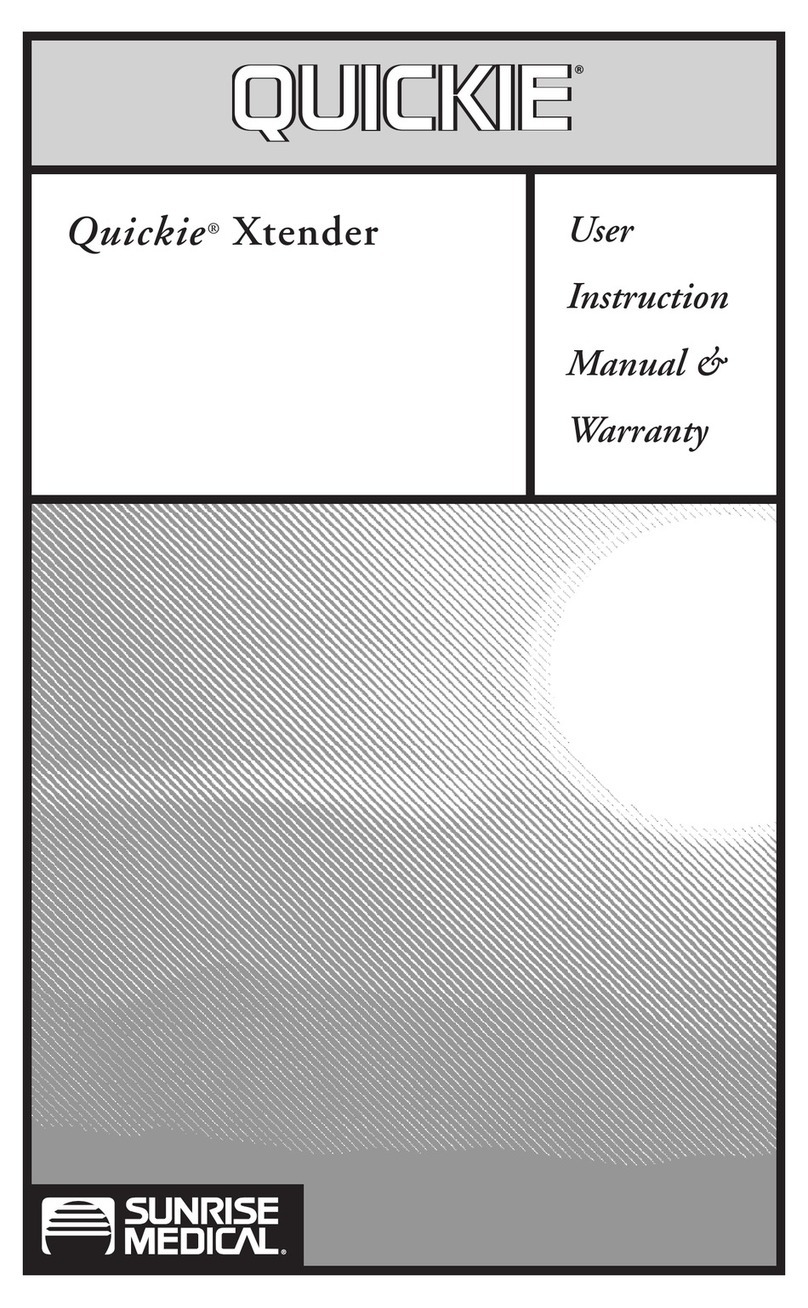
Sunrise Medical
Sunrise Medical Quickie Xtender User instruction manual & warranty

MultiMotion
MultiMotion M5 manual

Permobil
Permobil ROHO AirLITE Operator's manual
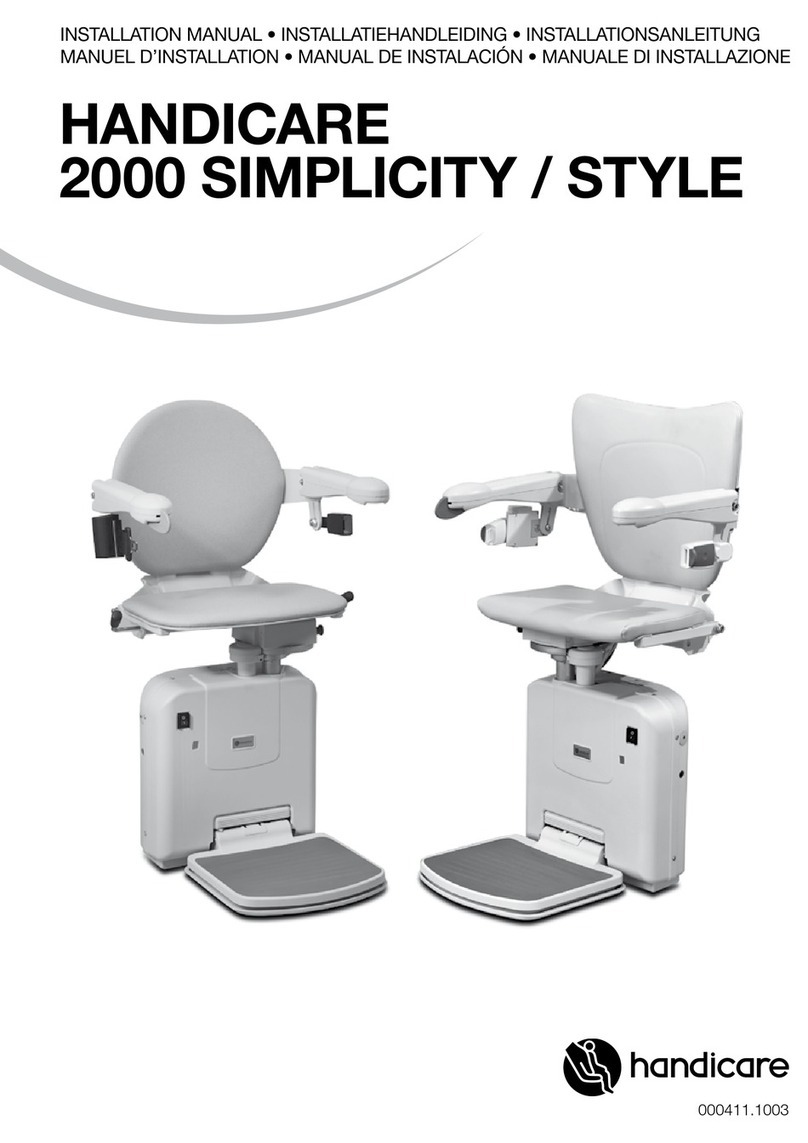
Handicare
Handicare 2000 SIMPLICITY installation manual

Pressalit Care
Pressalit Care R8073 Operation and maintenance manual
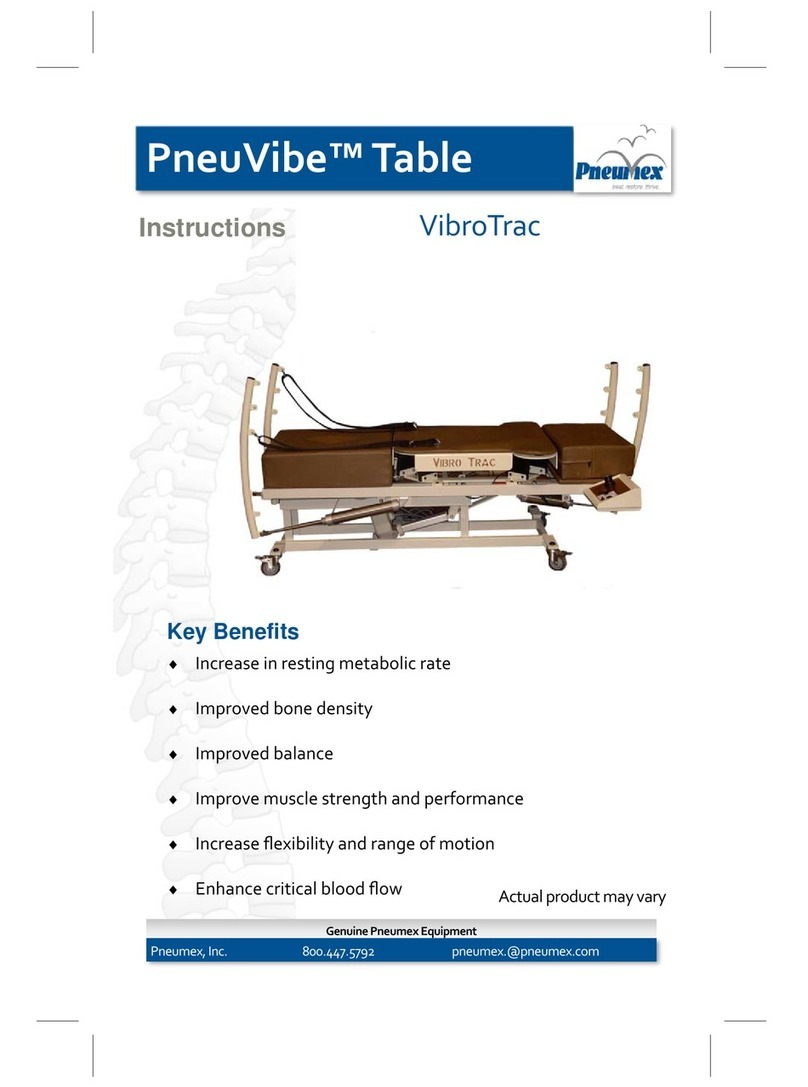
Pneumex
Pneumex Pneumex VibroTrac instructions
